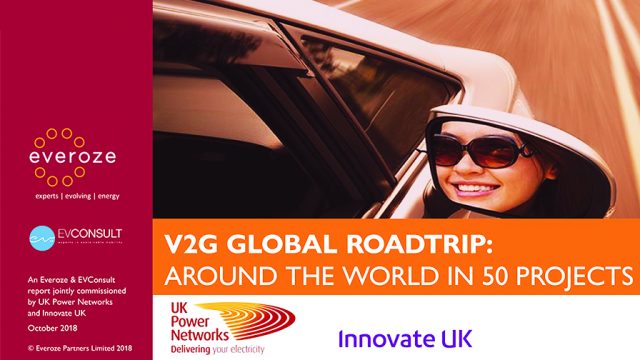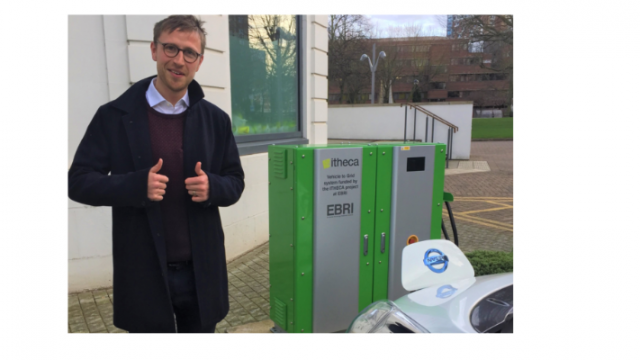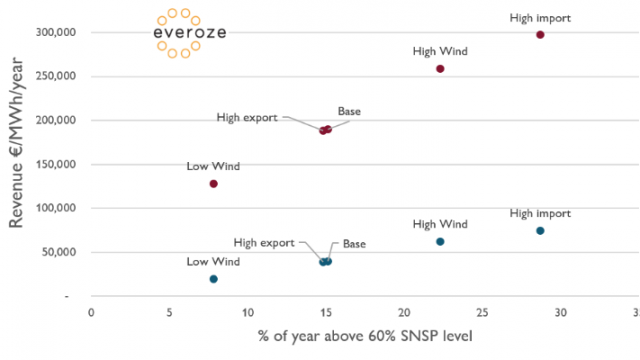Electric vehicles – four forms of flex for a renewable future
In his latest blog, Everoze partner Paul Reynolds describes the four forms of flex for a renewable future. Originally posted on LinkedIn on the 7th January 2019.
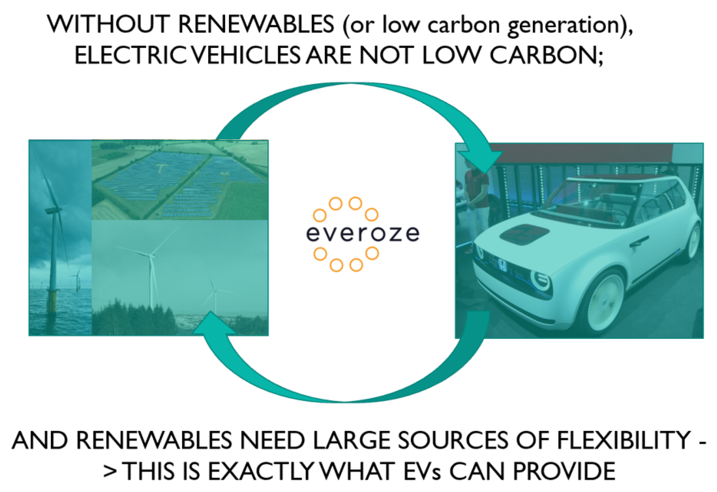
At Everoze our vision is for electric vehicles (EVs) to form an integral part of the electricity system. A world where EVs are not seen as a just a challenge to integrate into the network, but instead as an opportunity to integrate more solar, more wind and more EVs.
This short blog makes the case by:
- Explaining the four types of flexibility (or ‘flex’) available from EVs,
- Assessing how much flex each option could provide, and;
- Discussing three implications of this for the energy sector.
Four types of flex
Energy flexibility or ‘flex’ is the ability of hardware and software to vary supply of, or demand for, energy in response to system, network or market signals.
The shift to electric vehicles offers four types of flex to the energy system.
The first is smart charging, with the Government recently confirming that all chargers must be ‘smart’ by July 2019. Second is vehicle-to-grid (more details in the Vehicle to Grid report[1] we recently launched). Third is second life batteries but what is the fourth? Well I would like to introduce (and potentially coin) ‘pre-life’.
Each of the four is summarised in the table below.
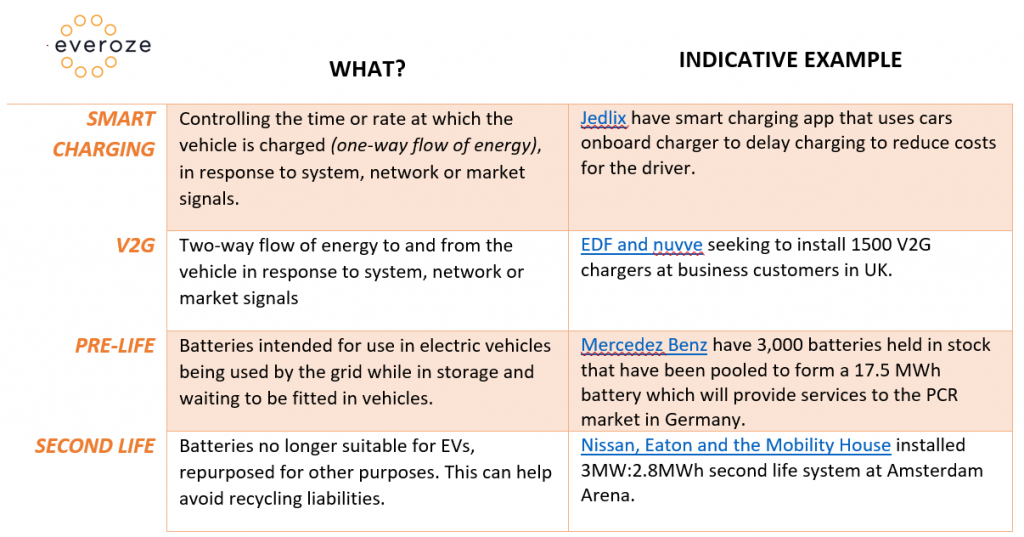
Just like stationary batteries, each of these four options can provide a range of ‘flex’ services to the system, network or market. These services include frequency response, constraint management, arbitrage, reserve, voltage control and peak shaving – all the services we at Everoze help our clients to understand, invest in and deliver into.
How much flex can EVs provide?
So we have defined them but let’s get quantitative – how much flex could these different options provide?
We got our envelopes out, made what we think are broadly reasonable assumptions (although still highly uncertain) and came up with the following figures.
(To be clear – these are ballpark estimates)
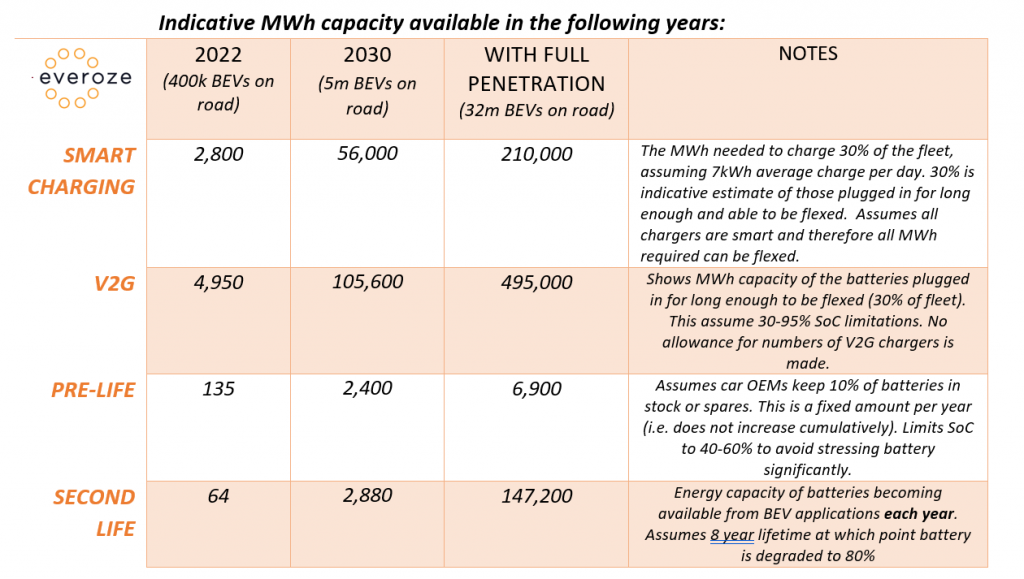
Despite being rough and ready, key takeaways from this analysis for us are:
1. This is a huge source of flex. The UK has gone through a battery boom in the last couple of years which has delivered about 500MWh of stationary batteries to date. By 2030 all four of these EV options could be offering GWh of flexibility. This is likely to be far more than the energy system needs!
2. Pre-life is important over the near term. We hear lots of talk about second life batteries but almost none about pre-life. Yet pre-life will precede the rapid increase in EVs, where as second life will follow it. This means that over the next decade pre-life could play an important role, even after considering a very limited SoC range for pre-life to avoid stressing the battery too much before it is used.
3. V2G offers greater technical potential than smart charging but is more challenging to access. Adding bidirectional charging unlocks the full potential of the battery capacity at the heart of EVs, while smart charging can only work while the vehicle is being charged. This mean that V2G offers the system much more flex, although with an increased cost of chargers and more complexity.
So what for the energy sector?
This huge source of flex will impact the energy sector in various ways. Here are just three:
Firstly. there will be competition to provide flex – this blog has focused on EVs but there are many other forms of flex including standalone batteries, hybrid heating systems, home energy storage systems, other forms of demand response in the home, interconnectors, not to mention hydrogen and power-to-gas technologies. The question is not whether we have enough flexibility to deliver a decarbonised energy system – we do [2]. Instead it is about which flex options will be most competitive at providing specific applications.
Secondly, there are now new owners of flex – the ‘owners’ of these flex resources will either be normal people driving around or the car OEMs. These are actors who to date have played almost no role in helping manage the electricity system. They will require new solutions and new partnerships, with convenience the key to unlocking the domestic market.
Finally, flexible EVs are great for renewables – the simple story for renewables is that more EVs, means more demand and therefore more renewables. This is true with or without flex. But the icing on the cake is that EVs providing flexibility will actually increase the energy price that renewables can capture. For instance, a recent Aurora study estimated that with smart charging, capture prices in 2040 go up 21% for solar, 13% for onshore wind and 11% for offshore wind, with EVs ‘effectively mopping up’ low priced electricity [3]. Given that we are in a subsidy free world this is incredibly significant and highlights a lovely symbiosis between flexible EVs and renewables.[4]
To conclude, electric vehicles will have a huge impact on the energy sector. Integrating them should not be seen as a challenge. Instead through their inherent flexibility, electric vehicles can help decarbonise not just the transport sector, but the power sector too. A nice thought for the New Year!
Any comments or views welcome.
[1] V2G report was commissioned by UK Power Networks and InnovateUK and produced with our partners EVConsult.
[2] BNEF, Eaton and Statkraft study recently concluded: ‘we find that near-100% carbon-free power can be achieved with known flexibility technologies. In our modelling, the presence of nuclear generation means that the zero-carbon share achieved is as high as 94% in 2040. Including clean imports under the interconnector scenario, the figure is as high as 96%.’
[3] Aurora study commissioned by REA, Eaton and Natwest
[4] For more detail on capture prices for wind and solar in Iberia see recent blog by my colleague Alex.
Honda image in header from https://www.autocar.co.uk/car-news/motor-shows-tokyo-motor-show/honda-urban-ev-readies-production-first-spy-shots

